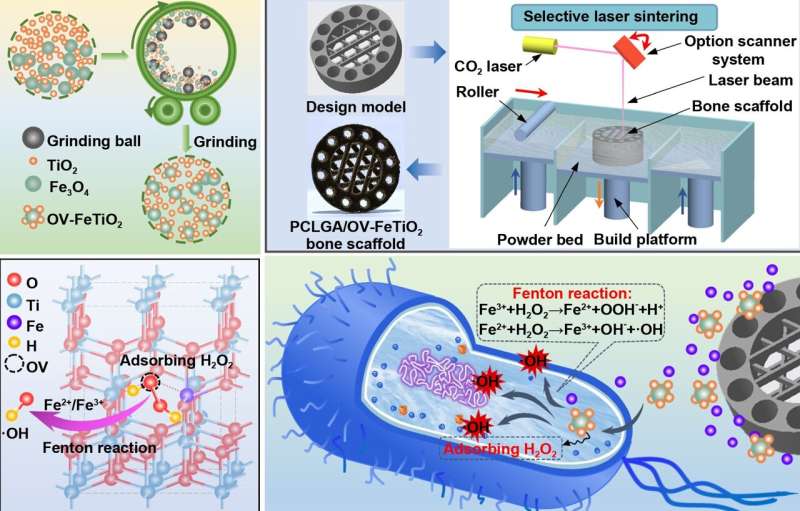This article has been reviewed according to Science X's editorial process and policies. Editors have highlighted the following attributes while ensuring the content's credibility:
fact-checked
proofread
Oxygen vacancy boosting Fenton reaction: A novel approach to fight bacterial infection in bone scaffold

The field of artificial bone transplantation has faced a significant barrier: bacterial infection, a common culprit that often leads to transplant failure and, in severe cases, devastating consequences such as amputation.
Published in International Journal of Extreme Manufacturing, new research led by scientists from Central South University pioneers an approach to address this significant barrier by enriching H2O2 from the microenvironment and amplifying the ability of Fenton reaction to functionalize bone scaffold with antibacterial properties.
Aiming for enhanced biocompatibility and safety, the team harnessed Fe-doped TiO2 nanoparticles enriched with oxygen vacancy defects to boost the efficiency of the Fenton reaction. These nanoparticles were synthesized from nano TiO2 and Fe3O4 through a high-energy ball milling process.
What sets this research apart is its multifaceted impact. By bolstering the antibacterial efficacy of the bone scaffolds, the team not only addresses the immediate challenge of bacterial infections but also paves the way for a more robust and resilient transplantation process.
The implications of this breakthrough are profound: a significant reduction in transplant failures, fewer post-operative complications, and a promising horizon for patients awaiting bone transplants.
Prof. Pei Feng, a professor from Central South University and the corresponding author of this research, commented, "Antibacterial artificial bone scaffolds are expected to solve the problem of bacterial infection after bone transplantation. With the development of modern bone tissue engineering and biomaterials, composite bone implants with multiple functions such as anti-infection, bone conduction and bone induction will have a good prospect in the repair and treatment of bone defects."
"Our innovative methodology lays the foundation for antibacterial bone scaffold treatments, holding the promise to drastically reduce associated complications."
More information: Cijun Shuai et al, Oxygen vacancy boosting Fenton reaction in bone scaffold towards fighting bacterial infection, International Journal of Extreme Manufacturing (2023). DOI: 10.1088/2631-7990/ad01fd
Provided by International Journal of Extreme Manufacturing



















